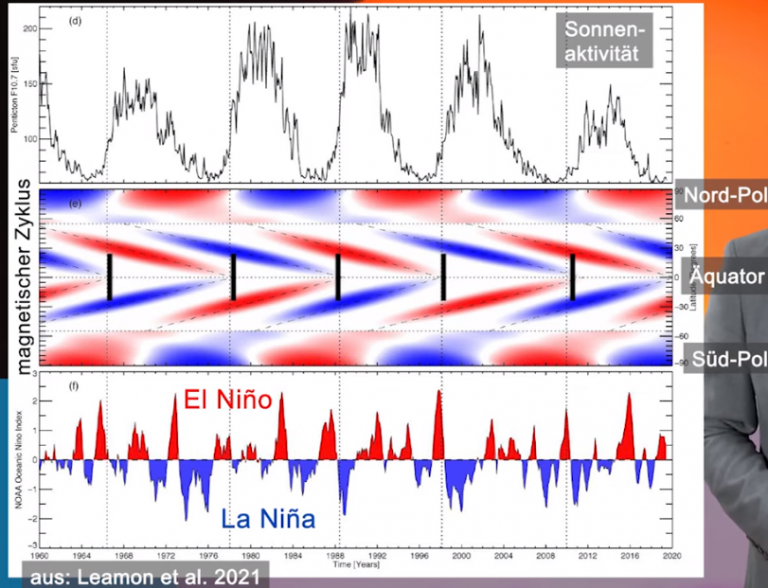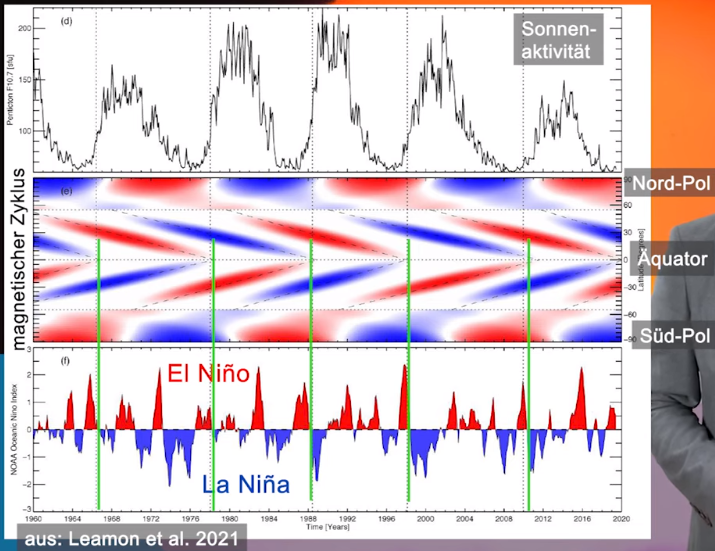A new, shattering study by scientists shows natural El Niño Southern Oscillations (ENSO) are undoubtedly linked to the 22-year Hale solar cycle – far beyond any coincidence. NOTHING TO DO WITH CO2.
German climate news site Die Klimaschau, Episode 36, reports on the new findings published in the journal of Earth and Space Science by Robert Leamon et al (2021). The new study ties solar variability to the onset of decadal La Niña events.
El Niño and La Niña events cause global temperatures to fluctuate by more than half a degree, and affect droughts and flooding globally. Predicting them would be extremely useful. However, their predictability has remained elusive.
The findings of the new paper promise, however, to vastly improve predictions, as these equatorial Pacific oscillations have now been linked to solar activity, principally “a more precise 22-year clock for solar activity, derived from the Sun’s magnetic polarity, which completes a full cycle every 22 years (Hale Cycle).
22-year Hale Cycle
The 22-year cycle begins when oppositely charged magnetic bands that wrap the Sun appear near the star’s polar latitudes. Over the cycle, these bands migrate toward the equator — causing sunspots to appear as they travel across the mid-latitudes of the Sun.
The cycle ends when the magnetic bands meet in the middle and terminate one another in what the research team calls a “terminator event”.
And whenever that happens, a new La Niña event begins.
Each yellow line coincides with the end of a solar 22-year Hale Cycle, which also happens to coincide with the start of a new La Nina – the onset of a marked global temperature drop.
The solar-ENSO clock
According to Eureka Alert, the researchers imposed these terminator events over sea surface temperatures in the tropical Pacific back to 1960 and found that the five terminator events occurring between 1960 and 2010-11 all coincided with a flip from an El Niño to a La Niña.
La Niña starts on time for 6th consecutive time!
The authors add: “The end of the most recent solar cycle — which is unfolding now — is also coinciding with the beginning of a La Niña event.”
The latest marks the 6th consecutive time. The chances of this happening, the scientists say, are much less than 1 in 5000!
Nothing to do with CO2
In the world of climate alarmism, the global temperature increases associated with El Niño events are often blamed on CO2. Nothing could be further from the truth.
And when global temperatures drop during times of La Niña – as has been the case once again for the current La Niña – alarmists choose to wait things out. But now it appears we have found a natural explanation – the solar 22-year Hale Cycle.
It has nothing to do with CO2.
The mechanism that acts between the Sun and the earth is still a mystery. The scientists believe it is linked by the the Sun’s magnetic field.
So, if you wish to know when we can expect a new La Niña, at the latest just wait until the start of the next solar cycle! Six consecutive times is no coincidence.







Should this say 11 solar cycle?
11,x years is half of a solar cycle which leads to an inverted solar magnetic field. 22,x years is the complete cycle with a complete cycle of the solar magnetic field.
Interesting to note that the points referred to occur shortly after solar minimum. This coincides with the Ap Leading edge delay associated with Spörer’s law discussed in https://howtheatmosphereworks.wordpress.com/ap-index-historical-analysis/ … In this consideration, the deepest drop in Ap activity occurs during the initial rise in sunspot activity rather than the actual solar minimum. At this point the most aggressive drop in terrestrial climate and temperature usually occurs.
‘… In the world of climate alarmism, the global temperature increases associated with El Niño events are often blamed on CO2 …’.
That is true, in fact the anthropogenic global warming hysteria in the public mind began with the 1998 El Niño event together with the Mann hockey stick graph (1999) and its use in the IPCC report (2001).
The general warming trend over the satellite era of about 0.15C per decade is unlikely due only to El Niño-La Niña cycles.
I may be misunderstanding, I’m not sure if that is the suggestion.
The last four times, yes, but not in ’77 or ’56. Those little blue blips are too tiny to count as La Niñas.
La ninas are warming events and el ninos are cooling evens. Sunlight short wave radiation is absorbed during la ninas and expelled during el ninos. Look at satelite global temp graph. Globe only warms during el ninos. No other warming. Atmosphere follows ocean temp. CO2 has no part in la nina or elnino.
There needs to be a large la nina or a series of medium la ninas to get a very large el nino large enough to warm the planet.
If solar cycle alignment theory can be proved this is crucial in predicting global warming or cooling.
[…] Amazing Results: A La Niña Begins When 22-Year Solar Cycle Ends… Now 6th Consecutive Time Since 1… […]
Hmm..
You’ll notice that each of those “11-year” green lines are a different distance apart. This all relies on the finding of a “more precise solar clock”. I understand there are a number of different ‘solar clocks’ they could have chosen. Is this the best fit??
Initial reaction is to be very sceptical of this, and they are really stretching things when they claim a 1 in 5000 chance of this happening randomly. Anybody with more knowledge of solar activity periods and the different ways to measure it chime in here, to put the paper’s assumptions into perspective?
Let’s not confuse Schwabe (11 year) with Hale (22 year) cycles.
A sceptical look says that the solar miniums are so vaguely defined and the lines connecting them to a la Nina is arbitrary drawn.
The minimums are not ill-defined. These are cycles on the back of cycles, carrying shorter cycles, that depend on extemely long cycles. This article treats solar magnetic cycles, but there are the passing of nearby planets, the sun itself does not stand “still” in some galactic orbit; it wiggles in a small circle to compensate for the vast gravity of Saturn. There’s the exact position of the moon on any given solstice to consider…
In other words, on the timescale of a cyclical planetary system, a year or two this side or that, is to be expected.
What you may miss, is the usual climastrology, where they “recreate” data for graphs far into history where nobody had the means to measure these thngs, and/or the graph extends for centuries hence, to show you how scary the wriggly lines really are.
All in all, those lines are pretty damn evenly spaced!
[…] Amazing Results: A La Niña Begins When 22-Year Solar Cycle Ends… Now 6th Consecutive Time Sin… […]